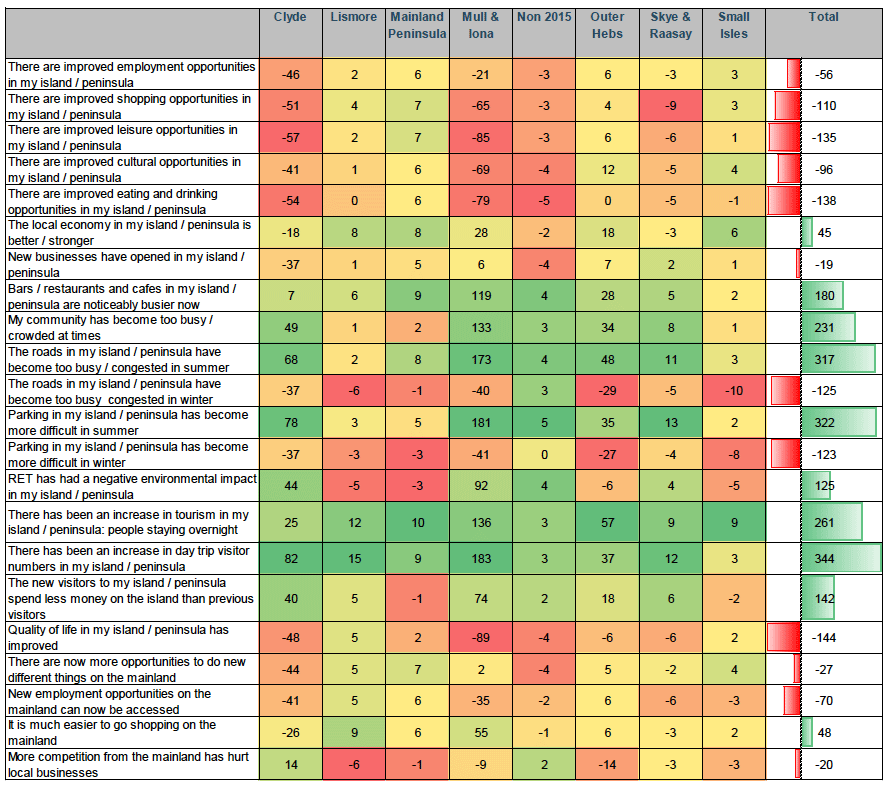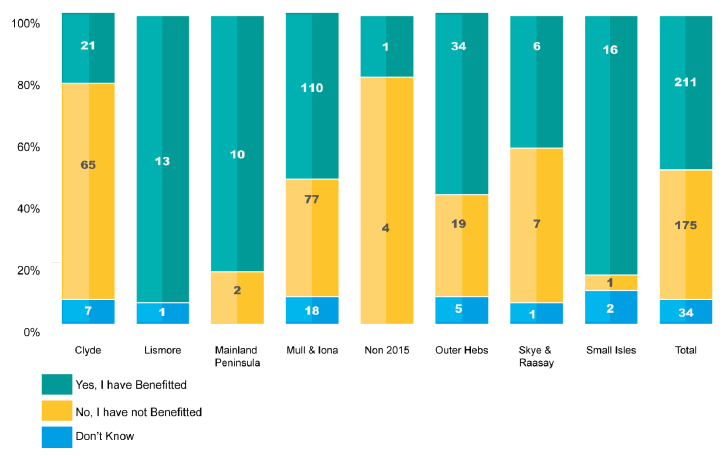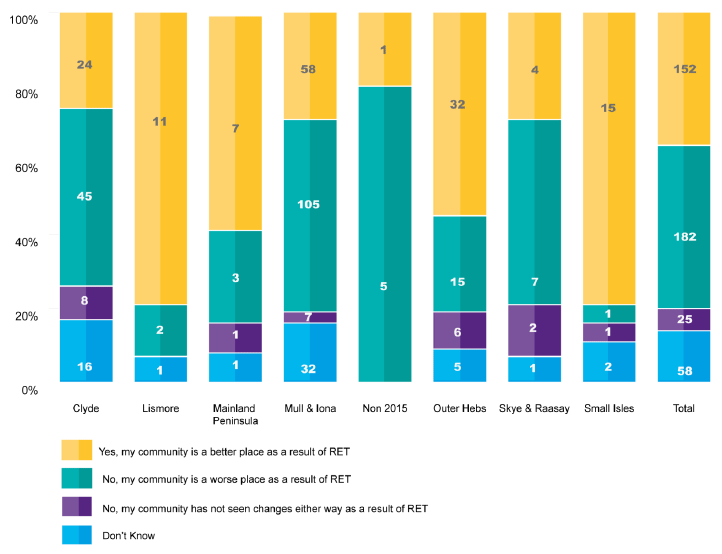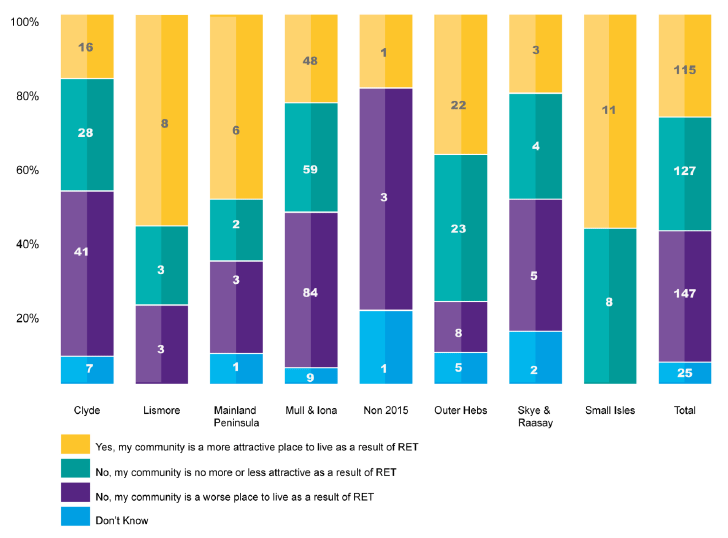6 What has been the impact on the communities affected by RET?
6 What has been the impact on the communities affected by RET?
Overview
The previous two chapters have established the consequences in the changes in travel behaviour influenced by RET. This chapter, which is focused on the ‘2015 RET’ routes only, establishes the impact of the policy on the communities concerned.
The analysis is again split by residents and businesses.
Residents
How has RET affected how people view the island / peninsular communities in which they live?
Respondents to the resident surveys were asked if they agreed or disagreed with a series of statements with respect to how their community may have been affected by RET – the chart below shows the net results (total agreeing minus total disagreeing) – it should be noted that:
- responses for each island / island group are shown down the columns, with the strength of agreement to disagreement shown in a shaded colour coding from green to red;
- the final column shows the net results overall.
Figure 6.1: Views on the impact of RET on communities (Source: Residents survey)

Overall:
- the statements which were most agreed with were
- there has been an increase in day trip visitor numbers in my island / peninsula
- parking in my island / peninsula has become more difficult in summer
- the roads in my island / peninsula have become too busy / congested in summer
- the statements which were most disagreed with were
- quality of life in my island / peninsula has improved
- there are improved eating and drinking opportunities in my island / peninsula
- there are improved leisure opportunities in my island / peninsula
- the roads in my island / peninsula have become too busy / congested in winter
Key point: There is widespread agreement that RET has increased day-trip visitor numbers to the ‘2015 RET’ communities, but concern that this has led to pressures on local infrastructure, particularly roads and parking. It should be noted though that the sample is dominated by Mull and Cumbrae, where these issues are most acute.
Do people feel they have personally benefitted from RET?
Outwith wider community impacts, respondents to the resident survey were asked if they had benefitted personally from the introduction of RET – the results are summarised in the figure below:
Figure 6.2: Have you benefitted personally from RET? (Source: Resident survey)

The figure shows that, overall, people think that they have personally benefitted from RET, even in Mull & Iona where there is a strong perception of wider disbenefits attached to the policy. The main reasons for this are likely to be an increase in disposable income and / or the ability to make journeys which were previously prohibitive due to the fare levels.
The key exception to the above is the Firth of Clyde communities included in the 2015 roll-out, with a significant majority identifying no personal benefit. This is likely to be strongly linked to the minimal reductions in fares experienced by most residents on these islands.
Key point: The majority of residents in the ‘2015 RET’ islands feel that they have personally benefitted from RET, even where wider perceptions of how the policy has impacted on their community is less positive. This is predominantly a result of increased disposable income and the ability to make journeys which were previously stymied by fare levels. The key exception is the ‘2015 RET’ islands in the Firth of Clyde, largely due to the minimal reductions in fares for residents on these islands.
Overall, do people think their community has benefitted from the RET policy?
The figure below shows how respondents to the resident survey view the impact of the ‘2015 RET’ roll-out on their communities:
Figure 6.3: Do you think your community is a better place to live as a result of RET? (Source: Resident survey)

Whilst the evidence suggests that people feel better off as a result of RET being introduced, more people overall in the ‘2015 RET’ islands now think their community is a worse place than prior to RET. These figures are however dominated by the islands in the Firth of Clyde (Bute and Cumbrae) and Mull & Iona).
Although samples are small, more residents of Lismore, mainland peninsulas, the Outer Hebrides, and the Small Isles think that their communities have benefitted from RET.
Key point: In the ‘2015 RET’ islands, more people overall think that their community is worse off as a result of RET, but this finding is strongly driven Bute, Cumbrae, Mull & Iona, where concerns over ferry and infrastructure capacity have been widely noted. In all other island groupings, RET has been considered to be positive for communities.
Overall, do people think that RET has made their community a more attractive place to live?
The final question in this part of the resident survey asked people whether they considered that the introduction of RET has made their community a more attractive place to live. The results are summarised in the figure below.
Figure 6.4: Has RET made your community a more attractive place to live? (Source: Resident survey)

Key point: Reflecting the previous question, more people think RET has made their community a less attractive place to live, but this is again driven by the Firth of Clyde islands and Mull & Iona.
Has RET encouraged more people to live on the islands?
Those who had moved to their community after RET had been introduced (n=83) were asked a series of questions regarding their decision to move there. The main findings are as follows:
- 72% were aware of RET when deciding to move
- of those who were not aware
- around half would have moved to the island anyway
- the other half would have thought twice about it if fares were higher
- of those who were aware
- 15% say they would not have moved to the island without RET
- so, 11% (i.e. 15% of 72%) of those who have moved to RET islands would not have moved there in the absence of the fares reduction
Key point: The evidences suggest that RET has contributed to in-migration to the ‘2015 RET’ islands, boosting in-migration by around 10%.
Business views
The business survey and interviews also gathered evidence on the extent to which RET has impacted on the island and peninsular communities in receipt of RET in 2015.
Has RET been good for island businesses?
Overall, there was a narrow majority view amongst businesses that RET has been a good thing for their firm. Of the 55 businesses which responded to this question, 29 noted that it has been beneficial, with 21 of the contrary view (5 businesses did not know).
Where RET was identified as a positive change, the business survey and stakeholder interviews almost universally identified increased custom linked to higher visitor numbers as the reason for this. For example, businesses on either side of the Sound of Harris crossing had identified an increase in day-trip and multi-centre holidays which in turn has grown customer numbers and turnover.
The more interesting issue here is perhaps the reasons why 21 businesses (almost 40% of the sample) noted that RET has had negative impacts. This is particularly the case in Cumbrae and Mull, where there was a net dissatisfaction of -2 and -3 respectively. The reasons for this were complex and numerous.
- One of the main factors contributing to dissatisfaction amongst island businesses is the impact of RET on available vehicle deck capacity on the ferry. 34 out of 56 businesses which answered the corresponding survey question noted that their business has been negatively affected by a lack of vehicle space. One third of these businesses are based in Mull & Iona, with a further 7 in Cumbrae (where the ferry is not bookable and long queues at peak times are reported in the resident survey).
- The capacity issue was also identified by one stakeholder as a deterrent to their business reliably serving customers on the mainland.
- It is reported that the ease and comparatively low cost of taking a car on the ferry is:
- increasing the number of residents travelling to the mainland for goods or buying mainland services
- encouraging visitors to buy goods on the mainland and take them to the island in their car, rather than travelling as a foot passenger and buying on-island
- Congestion and traffic management issues on several islands are also seen to make on-island work more difficult, particularly for tradespeople travelling between jobs and public transport operators. This was deemed to be a particular issue in Mull.
Key point: Whilst on balance RET is considered a beneficial policy for island businesses, this view is by no means universally held, particularly on islands close to the mainland which have been impacted by competition and visitor number levels which local infrastructure is incapable of accommodating. The impact of RET on ferry capacity is a key issue for island businesses, particularly in Mull.
Has RET been good for the community?
Whilst only a narrow majority of respondents feel that RET has been good for their business, a much larger majority think it has been good for the community overall. 32 of 55 responses noted that RET has been a good thing for their local community, with 16 businesses responding to the contrary (7 responded that they did not know).
The one exception to the above is Cumbrae, where 9 business considered RET to be detrimental to their community, compared to six which thought it was a good thing. Mull businesses were also only marginally in favour.
Of those which believe that RET has been positive, the reasons cited generally related to residents benefitting from increased disposable income associated with lower fares and the positive economic impacts associated with higher visitor numbers. Two area specific benefits were also cited through the stakeholder interviews:
- The introduction of RET on the Sounds of Barra and Harris was noted to have improved the economic connectivity of the Outer Hebrides. As well as facilitating tourism routes such as the Hebridean Way, it has also provided residents with more affordable access to other ferry services to the mainland as well as facilities on other islands.
- RET has reduced the cost of travel for children travelling from Ardnamurchan to Tobermory for school. In Morvern, RET has enhanced access to education / choice within the sector - there are now seven children from Morvern travelling to high school in Tobermory – this is considered a critical link and RET has helped to reduce the fares and made it sustainable.
The primary sources of dissatisfaction with RET were again related to ferry capacity and local infrastructure being unable to accommodate the increased visitor numbers imposed on it.
Key point: The consensus view amongst businesses is that RET has been a good thing for communities. Again, however, there are lower levels of satisfaction (and in one case dissatisfaction) with the policy in a subset of islands, predominantly as a result of ferry-related capacity issues and the inability of local infrastructure to accommodate the increased visitor numbers in the islands.
Has RET encouraged new businesses or business investment in the islands?
There two components to this question – has RET:
- encouraged new business formation in the islands
- prompted investment by existing businesses on the islands
It is important to reiterate that RET was only introduced to the subset of islands being considered here in October 2015. As has been seen in previous RET evaluation studies (e.g. the equivalent evaluation for Arran), investment decisions tend to lag the introduction of the policy by several years as businesses assess the effect of the policy on e.g. visitor numbers, yields, competition etc. The commentary presented below should therefore be read with the caveat that businesses may only now be beginning to make (or consider making) investments on the basis of RET.
New business formation
The business survey captured 15 businesses in the ‘2015 islands’ which were formed following the introduction of RET, of which:
- noted that RET was a factor in starting the business (4 identified it as a major factor and 3 as a minor factor). Most of these businesses were in the tourism and retail sectors
- noted it was not a factor.
Investment by existing businesses
The business survey also secured responses from 43 businesses which were established in the islands prior to the introduction of RET. Of these businesses:
- 22 had made an investment since RET was introduced and 21 had not
- of the 22 which have made an investment, RET was a contributing factor for one third of these businesses, although in most cases it was only generally considered a ‘minor’ influence.
Several cases of new investment were identified through the stakeholder interviews and there is a general finding from across the business survey and stakeholder interviews that RET has in most cases increased business confidence across the isles. This is particularly true for businesses in the tourism sector such as accommodation providers, tour companies, gift shops and visitor centres etc. A combination of higher visitor numbers and, in most cases, an extended season are the main contributing factors to this.
Key point: The business survey and stakeholder interviews found that RET has prompted business investment in a small number of businesses across several islands. These investments have typically been focused on businesses in the tourism sector, which are responding to increased visitor numbers and the extension of the season.
It is important to note that, as RET was only introduced to this subset of islands in 2015, the ‘investment impacts’ have not fully materialised. A number of businesses interviewed identified RET-related investments which were in the pipeline but had not yet been delivered.